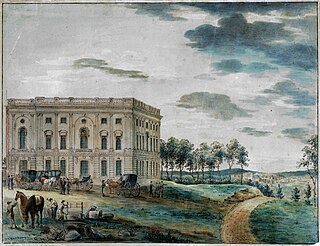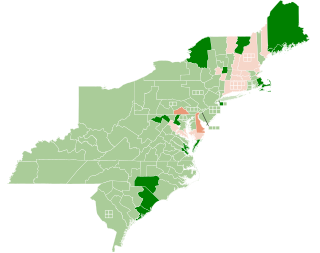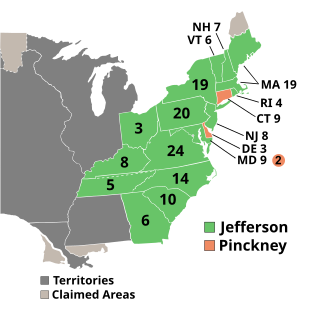
The Twelfth Amendment to the United States Constitution provides the procedure for electing the president and vice president. It replaced the procedure provided in Article II, Section 1, Clause 3, by which the Electoral College originally functioned. The amendment was proposed by the Congress on December 9, 1803, and was ratified by the requisite three-fourths of state legislatures on June 15, 1804. The new rules took effect for the 1804 presidential election and have governed all subsequent presidential elections.

The 8th United States Congress was a meeting of the legislative branch of the United States federal government, consisting of the United States Senate and the United States House of Representatives. It met in Washington, D.C. from March 4, 1803, to March 4, 1805, during the last two years of the first presidency of U.S. President Thomas Jefferson. The apportionment of seats in the House of Representatives was based on the Second Census of the United States in 1800. Both chambers had a Democratic-Republican majority.

The 9th United States Congress was a meeting of the legislative branch of the United States federal government, consisting of the United States Senate and the United States House of Representatives. It met in Washington, D.C. from March 4, 1805, to March 4, 1807, during the fifth and sixth years of Thomas Jefferson's presidency. The apportionment of seats in the House of Representatives was based on the Second Census of the United States in 1800. Both chambers had a Democratic-Republican majority.

The 1804 and 1805 United States House of Representatives elections were held at various dates in each state between April 24, 1804 and August 5, 1805. The Congress first met on December 2, 1805. The elections occurred at the same time as President Thomas Jefferson's re-election.
The second inauguration of Thomas Jefferson as president of the United States took place on Monday, March 4, 1805 in the Senate Chamber of the United States Capitol. The inauguration marked the commencement of the second four-year term of Thomas Jefferson as president and the first four-year term of George Clinton as vice president. Giving the oath of office was Chief Justice John Marshall.
The second 1804 United States Senate special election in New York was held on November 9, 1804, by the New York State Legislature to elect a U.S. Senator to represent the State of New York in the United States Senate.
The 1804 and 1805 United States Senate elections were elections that expanded the Democratic-Republican Party's overwhelming control over the United States Senate. The Federalists went into the elections with such a small share of Senate seats that even if they had won every election, they would have still remained a minority caucus.
The 1802 and 1803 United States Senate elections were elections for the United States Senate which resulted in the Democratic-Republican Party maintaining and expanding their majority of seats.

The 1802 United States House of Representatives elections in New York were held from April 27 to 29, 1802, to elect 17 U.S. Representatives to represent the State of New York in the United States House of Representatives of the 8th United States Congress.

The 1804 United States House of Representatives elections in New York were held from April 24 to 26, 1804, to elect 17 U.S. Representatives to represent the State of New York in the United States House of Representatives of the 9th United States Congress. At the same time, a vacancy was filled in the 8th United States Congress.

A special election was held in New York's 1st congressional district April 24–26, 1804 to fill a vacancy left by the resignation of John Smith (DR) on February 22, 1804, after being elected to the Senate. The election was held at the same time as the elections for the 9th Congress and were combined into a single election, with the candidate receiving the most votes going to the 9th Congress and the candidate with the second most votes going to the 8th Congress.

The majority requirement was met in all 17 districts in the 1804 elections.

A special election was held in Massachusetts's 12th congressional district on September 17, 1804 to fill a vacancy left by the resignation of Thomson J. Skinner (DR) on August 10, 1804

A special election was held in Delaware's at-large congressional district on October 1, 1805 to fill a vacancy resulting from the resignation of James A. Bayard, a Federalist, upon election to the Senate. Bayard had earlier served in the House in the 5th, 6th, and 7th Congresses before being narrowly defeated for re-election in 1802 by Caesar A. Rodney, whom he, in turn, defeated in 1804.

The Delaware United States House election for 1804 was held October 13–20, 1804. The incumbent Representative Caesar Augustus Rodney was defeated by the former Representative James A. Bayard Sr., whom he had defeated in the previous election, with 52.12% of the vote.

The 1804 United States elections elected the members of the 9th United States Congress. The election took place during the First Party System. The Democratic-Republican Party continued its control of the Presidency and both houses of Congress.

The 25th Massachusetts General Court, consisting of the Massachusetts Senate and the Massachusetts House of Representatives, met in 1804 and 1805 during the governorship of Caleb Strong. David Cobb served as president of the Senate and Harrison Gray Otis served as speaker of the House.

United States gubernatorial elections were held in 1804, in 13 states, concurrent with the House, Senate elections and presidential election.